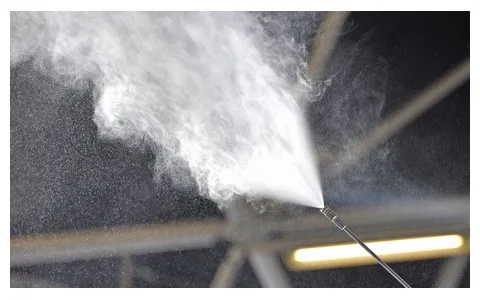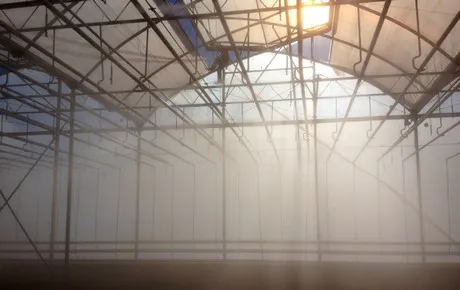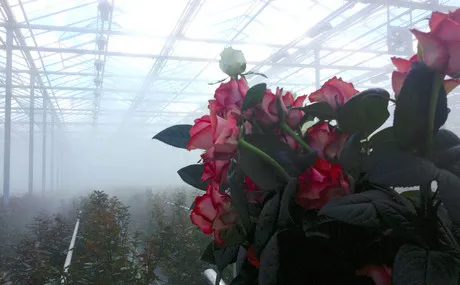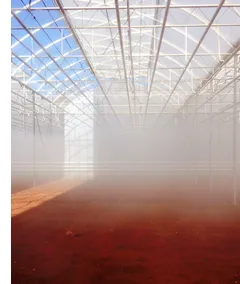Vincenzo Russo, of the Italian company VIFRA is specialised in the manufacture and installation of the High Pressure Fog System (HPFS. Russo was a third generation grower, formerly devoted to the cultivation of roses in the harsh climate of Italy. In the past he had to deal with the difficult conditions of the heat in Rome. “To be able to grow a good quality product we needed to find a way to control the humidity and reduce the temperature, and a HPFS was the answer,” explains Vincenzo.

VIFRA's Elvys Amico and Vincenzo Russo
 Prior to that, Vincenzo had tested various cooling systems from manufacturers in Israel, U.S. and other countries, but none delivered the expected results; this is what motivated him to start engineering the HPFS. Nowadays Russo has become famous with his VIFRA fog systems; colleague growers were impressed by the system and asked them to manufacture a similar one for them as well. Nowadays Russo’s company is fully devoted to the manufacturing of HPFS and other greenhouse controls. It is impressive to see what he has achieved over the years; even growers in the Netherlands who were not big fans of fog systems in the past are now interested in his technology. Recently he installed a system for tomato growers Looijen and AgroCare.
Prior to that, Vincenzo had tested various cooling systems from manufacturers in Israel, U.S. and other countries, but none delivered the expected results; this is what motivated him to start engineering the HPFS. Nowadays Russo has become famous with his VIFRA fog systems; colleague growers were impressed by the system and asked them to manufacture a similar one for them as well. Nowadays Russo’s company is fully devoted to the manufacturing of HPFS and other greenhouse controls. It is impressive to see what he has achieved over the years; even growers in the Netherlands who were not big fans of fog systems in the past are now interested in his technology. Recently he installed a system for tomato growers Looijen and AgroCare. According to Vincenzo, “the fog system creates the ideal climate, which consequently results in better produce and plants. Its effectiveness was gradually discovered by other growers and we currently deliver it to over 62 countries worldwide.”
The greatest advantage of the VIFRA HPFS is that while it is very efficient, it requires very low maintenance. VIFRA distinguishes itself; it is the only system in which all the components are made from stainless steel.

How it works
The soul of a HPFS is the adiabatic cooling processes; this consists in the forcing of pressurised water through nozzles, resulting in droplets of about 3-5 microns in diameter; the smaller the size, the bigger the benefit. This fog (or mist) evaporates the warm atmosphere of the greenhouse; the evaporation of water requires energy. This energy atomizes the fog which evaporates into the atmosphere resulting in a substantial decrease in the temperature of the greenhouse. If used properly, there is no increase in the chance of the appearance of diseases like botrytis.
Vincenzo assures that “it is only a matter of time before every advanced greenhouse grower installs a HPFS, as despite the fact that many still solely focus on the control of four factors: temperature, light, nutrients and CO2, controlling humidity is also extremely important. By using the HPFS, you can even allow more light in your greenhouse while preventing stress; growers do not have to use shading paint to cool down in Harsh summer months. A HPFS creates the perfect climate at the most affordable price.”
 The advantages of the system go beyond temperature control, as it is primarily intended to regulate the humidity levels, which can significantly drop, regardless of the temperature, depending on the wind’s strength and direction. “In dry conditions, plants close their stomata and they cannot breathe, which can lead to a waste of both time and production. Growers who installed a HPFS actually end up using it a lot more than they initially expected,” concludes Vincenzo Russo.
The advantages of the system go beyond temperature control, as it is primarily intended to regulate the humidity levels, which can significantly drop, regardless of the temperature, depending on the wind’s strength and direction. “In dry conditions, plants close their stomata and they cannot breathe, which can lead to a waste of both time and production. Growers who installed a HPFS actually end up using it a lot more than they initially expected,” concludes Vincenzo Russo.For more information:
VIFRA S.r.l.
info@vifraitalia.it
www.vifraitalia.it
